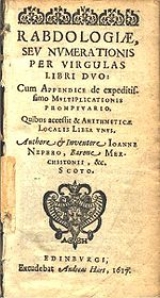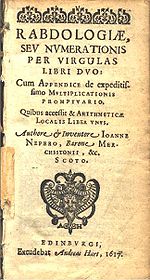
Rabdology
Encyclopedia

by John Napier
John Napier
John Napier of Merchiston – also signed as Neper, Nepair – named Marvellous Merchiston, was a Scottish mathematician, physicist, astronomer & astrologer, and also the 8th Laird of Merchistoun. He was the son of Sir Archibald Napier of Merchiston. John Napier is most renowned as the discoverer...
was published in Edinburgh. Printed three years
after his treatise on the discovery of logarithm
Logarithm
The logarithm of a number is the exponent by which another fixed value, the base, has to be raised to produce that number. For example, the logarithm of 1000 to base 10 is 3, because 1000 is 10 to the power 3: More generally, if x = by, then y is the logarithm of x to base b, and is written...
s and in the same year
as his death, it describes three devices to aid arithmetic calculations.
The devices themselves don't use logarithms, rather they are tools to
reduce multiplication and division of natural numbers to simple
addition and subtraction operations.
The first device, which by then was already popularly used and known
as Napier's bones
Napier's bones
Napier's bones is an abacus created by John Napier for calculation of products and quotients of numbers that was based on Arab mathematics and lattice multiplication used by Matrakci Nasuh in the Umdet-ul Hisab and Fibonacci writing in the Liber Abaci. Also called Rabdology...
, was a set of rods inscribed with the
multiplication table. Napier coined the word rabdology (from
Greek ραβδoς [rabdos], rod and
λoγoς [logos] calculation or reckoning) to describe
this technique. The rods were used to multiply, divide and even find
the square roots and cube roots of numbers.
The second device was a promptuary
Promptuary
In mathematics, the promptuary is a more complex version of Napier's bones which makes it easier to perform multidigit multiplication....
(Latin promptuarium meaning
storehouse) and consisted of a large set of strips that could
multiply multidigit numbers more easily than the bones. In combination
with a table of reciprocals, it could also divide numbers.
The third device used a checkerboard like grid and counters moving on
the board to perform binary arithmetic. Napier termed this technique
location arithmetic
Location arithmetic
Location arithmetic is a technique to do binary arithmetic using a chessboard-like grid. John Napier termed the technique in his treatise Rabdology, from the way that positions of counters on the board represented numbers....
from the way in which the locations of the
counters on the board represented and computed numbers. Once a number
is converted into a binary form, simple movements of counters on the
grid could multiply, divide and even find square roots of numbers.
Of these devices, Napier's bones were the most popular and widely
known. In fact, part of his motivation to publish the treatise was to
establish credit for his invention of the technique. The bones were
easy to manufacture and simple to use, and several variations on them
were published and used for many years.
The promptuary was never widely used, perhaps because it was more
complex to manufacture, and it took nearly as much time to lay out the
strips to find the product of numbers as to find the answer with
pen and paper.
Location arithmetic was an elegant insight into the simplicity of
binary arithmetic, but remained a curiosity probably because
it was never clear that the effort to convert numbers in and out of
binary form was worth the trouble.
An interesting tidbit is this treatise contains the earliest written
reference to the decimal point (though its usage would not come into
general use for another century.)
The computing devices in Rabdology were overshadowed by his seminal
work on logarithms as they proved more useful and more widely
applicable. Nevertheless these devices (as indeed are logarithms) are
examples of Napier's ingenious attempts to discover easier ways to
multiply, divide and find roots of numbers. Location arithmetic in
particular foreshadowed the ease of and power of mechanizing binary
arithmetic, but was never fully appreciated.

